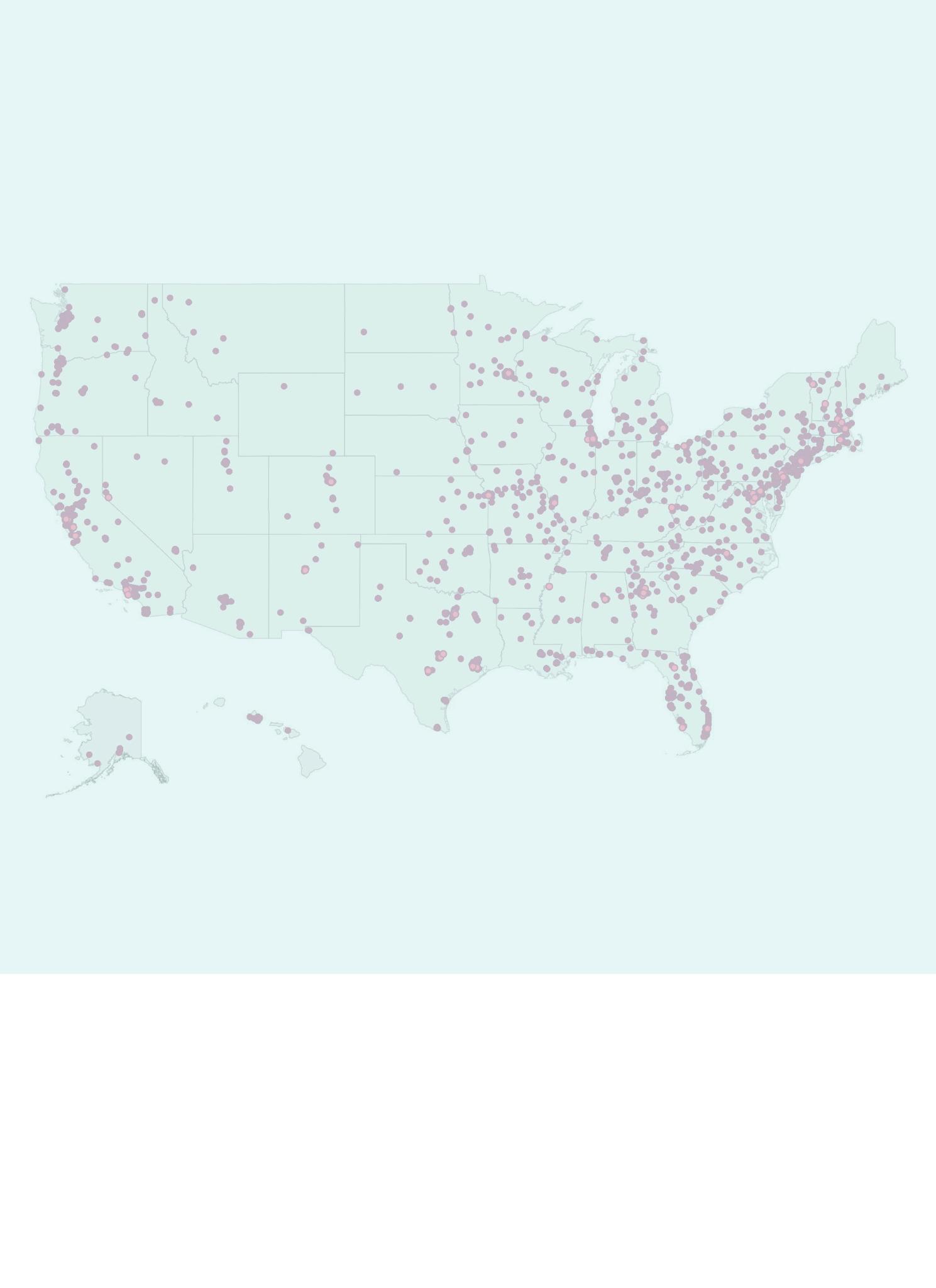

About New Profit
New Profit is a venture philanthropy organization that backs social entrepreneurs who are advancing equity and opportunity in America. New Profit exists to build a bridge between these leaders and a community of philanthropists who are committed to catalyzing their impact. New Profit provides unrestricted grants and strategic support to a portfolio of organizations led by visionary social entrepreneurs to increase their impact, scale, and sustainability. It also partners with social entrepreneurs and other cross-sector leaders to shift how government and philanthropy pursue social change to ensure that all people can thrive. Since its founding in 1998, New Profit has invested over $350M in 250+ organizations and, through the America Forward Coalition’s collective advocacy efforts, has unlocked over $1.9B in government funding for social innovation. Learn more at www.newprofit.org.

Acknowledgments
We would like to give a special thanks to everyone whose insights and investment made this project possible, especially our seventeen interviewees who took the time to share their wisdom, recommendations, and experience with us. Additionally, we’d like to thank the teams at People Rocket and New Profit for their willingness to learn and unlearn, iterate and iterate again, throughout this project Deep appreciation to the core team that led this work– from New Profit: Abby Marquand, Kendall Stanley, David Levy, and Lindsey McClenny From the People Rocket team: Tessa Forshaw, Jake Hale, Emily Meland, and Victoria Lee.
Our Design Challenge: How might we reach beyond our traditional networks to identify a diverse and inclusive pool of organizations?
In 2023, philanthropies gave an estimated $500 billion to U S charities, a substantial sum in a $28 trillion economy Yet, we see that philanthropic dollars aren’t equitably distributed Organizations with leaders of color, with non-traditional educational backgrounds, and/or non-native English speakers were disproportionately undercapitalized Organizations in rural and remote areas also received less than a representative share The end result is a loss of creativity and impact, as recipients with innovative ideas or deep knowledge of communities fall short on resources, and grave social problems get addressed slowly or not at all.1

“Stakeholders who control how capital flows in the social sector have historically tended to be an elite, largely white group that does not reflect the diversity of the communities they ultimately aim to serve. The overwhelming majority of individuals in positions of power are often least proximate to Black and Latinx leaders and communities and therefore less familiar with the challenges they face.”
- Transforming the Social Sector, a concept paper by New Profit, published Feb. 24, 2020
A major cause of this disparity lies in philanthropic pipeline development, or how funders identify organizations for funding This system has long had design flaws, with funders relying on their own networks to find potential grantees This inequitable distribution of social capital tied to material wealth leads to bias in pipeline development Those with limited networks tied to philanthropy have trouble acquiring funding, while others in the "right" networks receive numerous grants.2
Defining “Pipeline”
“Pipeline” is the overall term for the pool of potential organizations that we might fund based on eligibility criteria. The “top of the funnel” is an analogy for all the possible organizations that could be considered before entering into any sort of open call, invitation, or participatory application, screening, and diligence process We sought to expand the organizations at the top of the funnel well beyond our current networks.

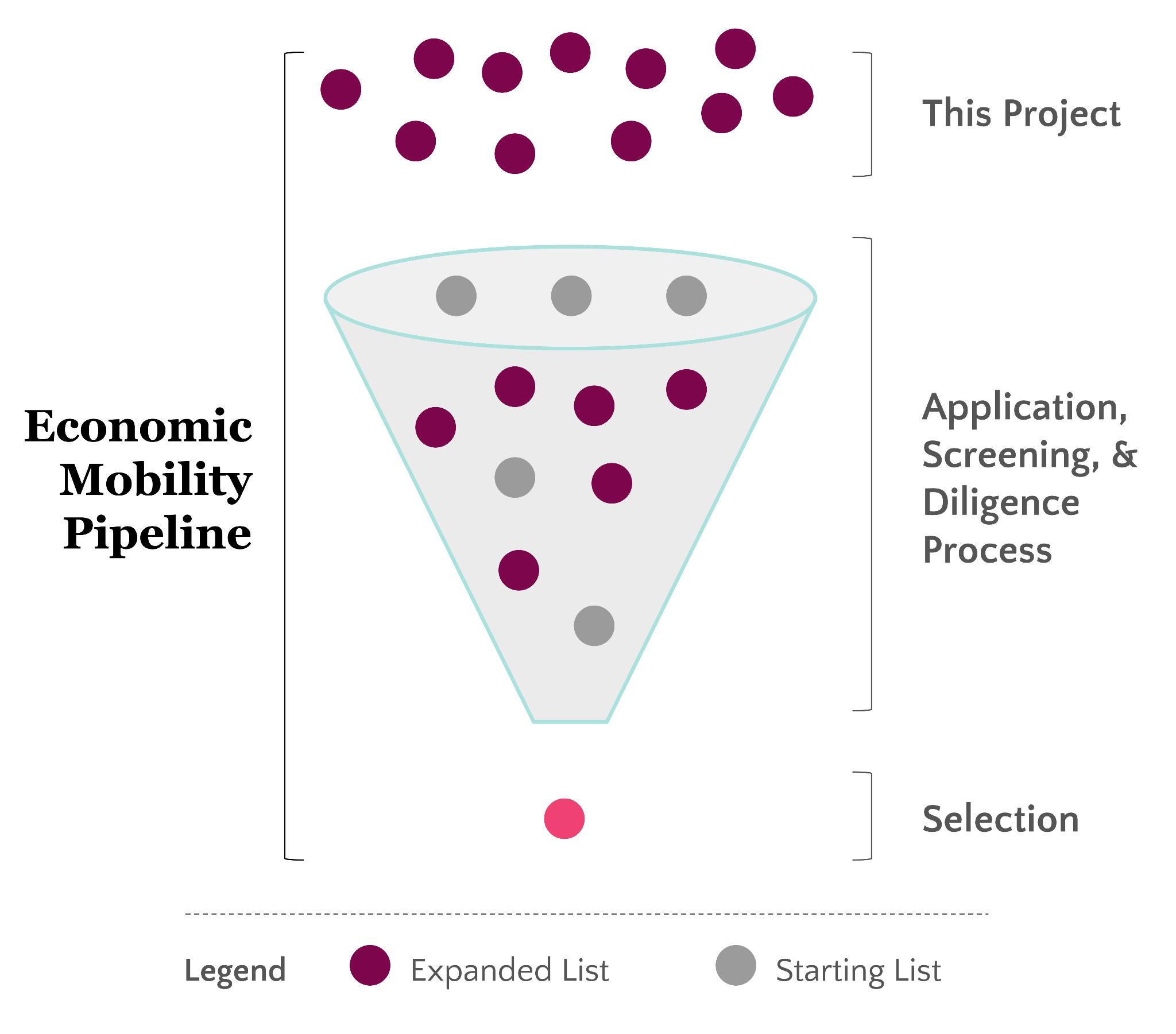
While some funders have tried to broaden their searches to fund underrepresented identities and approaches, the "who you know" problem persists, limiting the pool of potential grantees. Historically undercapitalized social entrepreneurs, including but not limited to female, Black, Latinx, 4
and Indigenous leaders, still encounter barriers 3 Innovative, community-driven solutions, which often serve those farthest from opportunity, go overlooked
Funders must address this problem, not only because we leave impact on the table by underinvesting in these proximate approaches, but also because it is the right thing to do to promote equity in a system that rarely considers the unintended consequences of its work As a step forward, New Profit partnered with responsible design firm People Rocket to ask: "How might we reach beyond our traditional networks to identify a diverse and inclusive pool of organizations?"
We identified a need to be more expansive in our pipeline development process, widening the "top of the funnel" of our pipeline with equity at the forefront
We noticed that funders, us included, have no single place to discover the breadth of social entrepreneurs and organizations doing impactful work in communities across the United States; nor are there commonplace exhaustive or comprehensive lists of organizations for consideration. Because demographic groups are not inherently connected nor are they a monolith, regional, political, and community differences mean that intentional identification, outreach, and relationship-building beyond our typical networks are necessary for creating more equitable and inclusive pipelines.
Our Goal: Equitable Philanthropy
Throughout this project, we looked to create insights that might influence more equitable pipeline development We wanted to expand funders' view of a viable pipeline development process, moving beyond network-based or open-call outreach. We set out to make the “top of the funnel," or the realm of possible organizations for investment consideration more expansive and inclusive, starting with the pipeline for our economic mobility issue area We aimed to:
● Pilot a novel method to identify and learn about potential organizations for investment
● Identify the breadth of nonprofits driving economic mobility, expanding our view of proximate leaders and organizations that identify as Black, Indigenous, Latinx, and AAPI
● Inform public and private actors that similarly seek to expand their understanding of the economic mobility landscape
● Inform our investment criteria and influence other philanthropy along those same lines
● Create an easy-to-use tool that can be adapted and improved over time
● Publicly share insights and findings
● Lift up promising organizations and their approaches
We see the responsible design process expanding our economic mobility pipeline while serving as a model and catalyst for philanthropy
Our Approach: Responsible Design
Without care and attention, design often exacerbates structural inequity by giving precedence to dominant voices and perspectives To disrupt this tendency, we made a commitment to responsible design.4
Responsible design draws on design practices from design thinking, human-centered design, innovation, and design-based research, but centers on equity and a deep consideration of unintended consequences This ensures that the work we do responds to and addresses human needs in an actionable way, and in the process, we can generate a more equitable and inclusive structure and product
By considering unintended consequences, seeking diverse perspectives, and generating deliberate solutions, responsible design can help us hold ourselves accountable for creating positive impact and shaping a better world.
Economic Mobility at New Profit
New Profit, a nonprofit venture philanthropy organization, backs breakthrough social entrepreneurs advancing equity and opportunity in America. Our economic mobility work focuses on investing in proximate leaders and their expertise, advancing their impact through unrestricted grants and capacity building. Through our Catalyze and Build support models, social entrepreneurs are selected for unrestricted capital, learning communities, coaching, and robust technical assistance from our most senior partners. This work is complemented by a focus on the broader ecosystem, where New Profit seeks to advance systemic change through our convening power, thought leadership of our network of social entrepreneurs, and policy efforts. Since 2006, New Profit has invested more than $80 million in economic mobility, and we anticipate growing this portfolio over the next several years.

Our Methodology: Human-Centered Algorithm Design
To revamp our pipeline development process, we employed human-centered algorithm design5 , an approach uncommon in our industry This approach helped us radically expand our view of organizations and communities that were previously unknown to us or outside our networks, all while being more mindful and responsible.
Traditional algorithm design is quite different from a design that is human-centered It works as a “black box,”6 generated by small technical teams focused on optimization and efficiency. Designs are opaque to everyone else Even people like us, who use tools that run on algorithms every day, have no way of understanding how the algorithm generated a specific output The black box approach feeds concerns around trustworthiness, bias, and equity
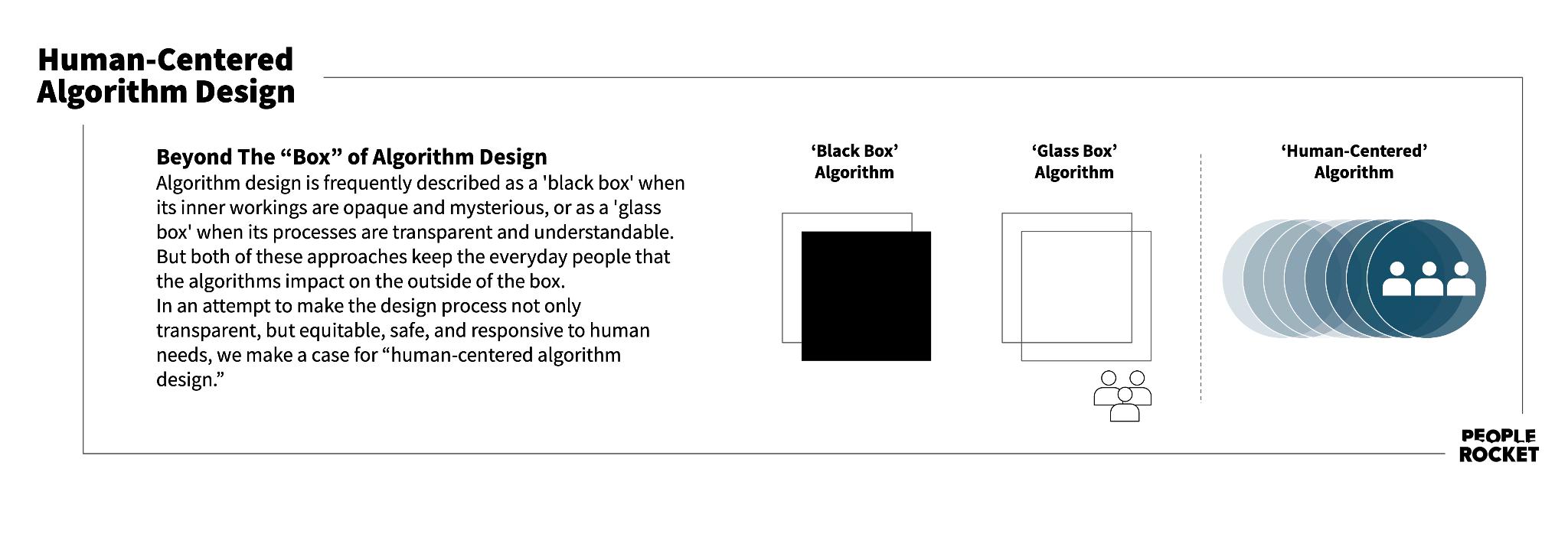
To fix this problem, we started with a “glass box” approach,7 where people who are proficient in the field can understand how it works That’s good for transparency, but to make the algorithm equitable and responsive to human needs, we also need to put people at the center
Human-centered algorithm design
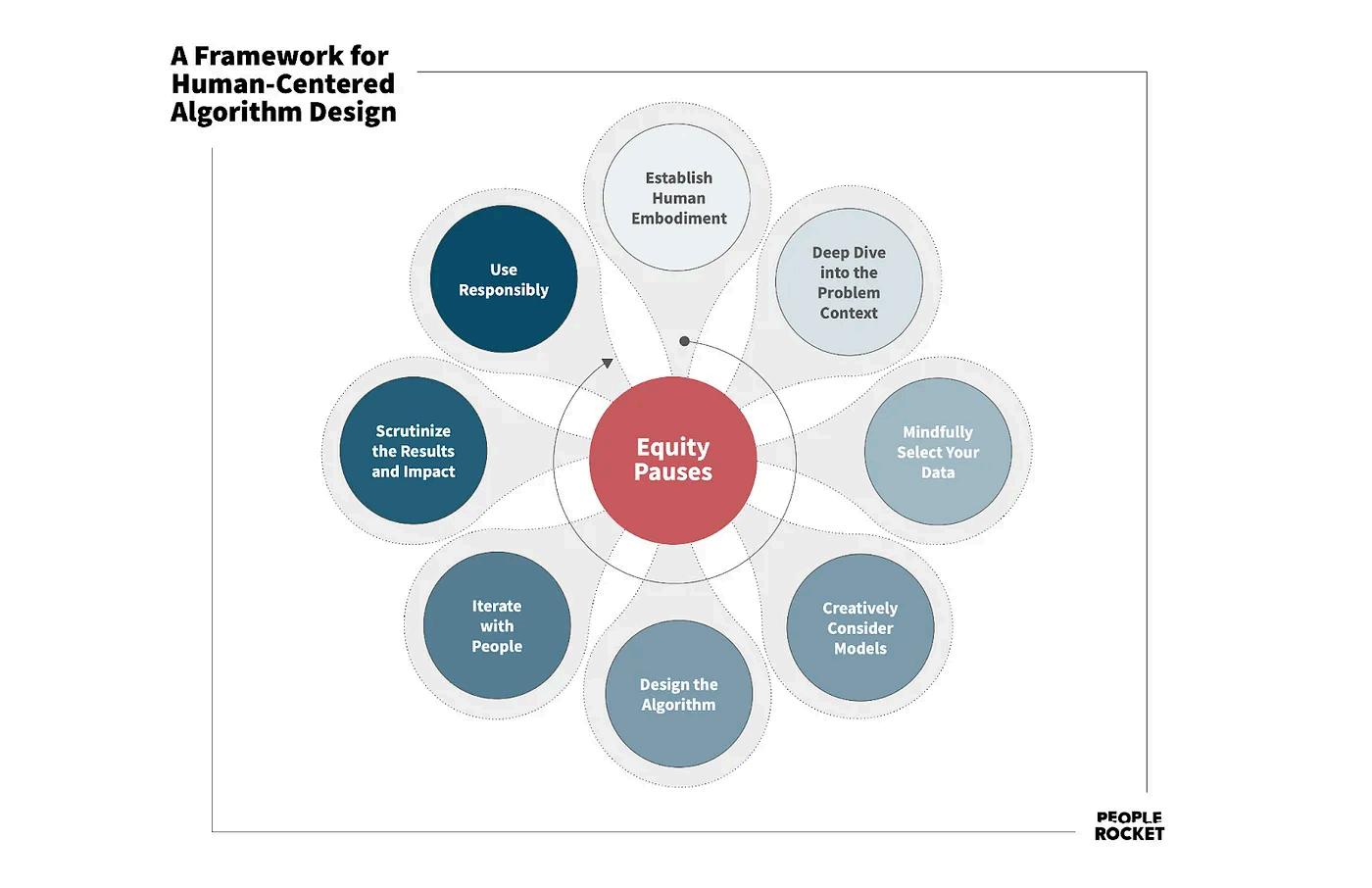
D) is a radically collaborative, -methods process that es stakeholders from diverse ounds to co-design the hm 7 With People Rocket and stakeholders, we built an hm that narrowed the IRS Tax t Organization dataset (Form down to a manageable list d on economic mobility.8 Note e algorithm worked only to d the pipeline of organizations ay be considered for ment and has no bearing on ment selection, which at New s still a very human process
The algorithm makes our funnel expansive by working from the entire universe of non-profit organizations submitting Form 990s But we adjust it, informed by qualitative interviews and pauses to check for equity, so the results are also more inclusive. HCAD goes through eight stages, but the process is fluid and highly iterative, so no numbers are presented
Each stage includes an Equity Pause These pauses, which are based on the principles of responsible design, make sure that we take into account both intended and unintended consequences of each of our decisions “Equity Pauses” entail dedicated reflection time to engage with guided questions and challenge designers to hold themselves accountable to a more equitable process and product. Below is how we developed our algorithm.
Establish Human Embodiment: We started by engaging with people traditionally excluded from technological spaces, teaching them to think like an algorithm This step involves interactive and physical activities to demystify algorithmic processes and address potential biases and unintended consequences in design.
At the beginning of the project, we held a meeting to discuss algorithms Someone noted, “Most stakeholders hear ‘algorithm’ and they get concerned.” So we held multiple tactile sessions to experience how algorithms work, often using Miro boards and post-it notes to build them out step by step Participants learned how an algorithm extracts information from data sources, transforms it into a usable format, and loads it into an interface for end users. Participants asked questions until they felt comfortable Soon they were able to discuss algorithms conversantly, blending their understanding with the project’s human needs
Once we established an understanding of algorithms, we then moved on to potential biases and unintended consequences We worked to identify areas where an algorithm could potentially perpetuate inequalities, for example only capturing organizations that use language traditionally preferred by funders. Through discussions, we encouraged participants to think critically about how algorithms could impact different communities
Deep Dive into the Problem Context: Using interviews and other qualitative methods, we gathered a broad range of perspectives and began to shape the problem statement This step emphasizes understanding the social context and making user-centric decisions.
People Rocket interviewed New Profit staff (the algorithm users) and 17 external stakeholders, who were designated as "network nodes" due to their connections with other social entrepreneurs and organizations outside of New Profit's usual networks
Before conducting interviews, we took a moment to pause for equity and revised our interviewee list to ensure that we spoke with individuals from various backgrounds, identities, areas of expertise, and communities We also compared this list to New Profit's traditional network of peer funders, which drove us to seek out interviewees who were connected to our target communities beyond those we already knew.
We used a "snowball" or network sampling method, in which interviewees recommended additional contacts. As a result, we spoke with people from a variety of communities across the country, in addition to the well-known nonprofits focused on economic mobility, national networks of workforce organizations, conveners and think tanks, and community colleges
Mindfully Select Your Data: We considered the options and focused on the data that best served our problem and technological solution From the interviews, we gathered referred organizations that aligned with our broad definition of economic mobility We identified their common attributes and also the data needed to meet our requirements, such as total revenue, total expenses, leadership, mission, and programmatic models
As we intended to create something that could serve as a public good, we ruled out proprietary data sources However, we still needed to identify nonprofits that met our criteria After considering several datasets, such as the federal government’s trainingproviderresults.gov and the Harvard Project on Workforce’s Workforce Almanac, we concluded that the IRS' Tax Exempt Organizations Database was the right fit We supplemented this dataset with county-level data to gain insight into the local labor force, unemployment, inequality, and income 9
With this wealth of information, we explored key words that might act as a proxy for our grantmaking priorities With each potential proxy, we paused for equity and asked ourselves, “Who are we including and who might we be leaving out if we use this proxy?”
Creatively Consider Models: We examined analytical models to determine which best suited the project's needs. We thought creatively and explored various modeling techniques, whether for classification, regression, or clustering
We decided on a multi-rule-based model that classified organizations as either in or out of the pipeline. It works by implementing a predefined set of conditions and rules to categorize data into different groups We did that mainly to boost both interpretability and transparency A highly transparent and interpretable model made it easy to explain the algorithm’s rules and decisions, enabling anyone to see which rule removed an organization from the down selection process. This afforded us the option to revisit rules iteratively to ensure that organizations we expected to appear in the dataset did
Transparency in the algorithmic process is also important for sharing this approach with the broader ecosystem By making the model transparent, the approach can be implemented by other funders in the ecosystem Transparency also means that others might see impacts, biases, or affordances that we don’t. These improve the reach and equity of the economic mobility ecosystem overall
Design the Algorithm: We did this methodically, step-by-step, mapping out the algorithm and building its technical architecture It centered on two sets of rules: one identifying nonprofits that satisfied our basic requirements (tax-exempt, not too big or small); and the other selecting organizations aligned with our model of economic mobility work
To develop the second set of rules, we started with a list of 99 organizations already identified and considered for funding by our team We deployed a natural language processing algorithm to extract common terms and phrases from their mission statements and turned them into our first "bag of words.” We then did the same with about twenty organizations, either referred to us from the interviews or identified through comprehensive desk research
We applied both sets of rules to the IRS database, which contained over 300,000 organizations for the most recent year, 2022. The results yielded around a thousand nonprofits. However, this was only the first iteration, and few algorithms are perfect on the first try It was time to benchmark the algorithm and obtain feedback from real human beings
Iterate with People: Feedback from many human beings was essential We kept iterating on the algorithm, akin to a feedback loop in product development We only stopped when those who would be most impacted by the algorithm's outputs felt confident that it accurately reflected their needs and experiences.
Through iterating with end users and those impacted by the project, we improved the algorithm in two ways, one qualitative and the other quantitative. We held a workshop where participants looked over nonprofits the algorithm had approved Their discussion enabled us to fine-tune the second set of rules and add an additional bag of words
To benchmark the algorithm's latest output, we conducted a second activity, comparing it with a reference list of organizations we had considered in a previous funding cycle We reviewed each instance and made further adjustments to the algorithm's rules.
We then took a moment to pause for equity again We considered the possibility of unintentionally creating pre-existing structures, systems, or institutions with the selected bag of words We explored ideas that worked against these structures, systems, and institutions to ensure fairness in the algorithm's downselection
Scrutinize the Impact: We now had a satisfactory algorithm, but we delved into its subtleties by testing specific outputs This in-depth analysis helped us address the broader implications of the algorithm, making explicit and agreed-upon tradeoffs
Periodically, we would evaluate the latest output, randomly select a few dozen organizations, and scrutinize if they belonged in the pipeline We also reviewed those that did not make the cut After each round of testing, we added or removed words and assigned priority levels to different words Additionally, we created a bag of “negative” words that indicated an organization was not a good fit for our purposes
We consistently questioned the potential unintended consequences of including or ruling out particular organizations from the pipeline Through this iterative process, we were able to generate a list of 2,465 organizations that reflected our team's focus on economic mobility in the United States The end result was a more extensive, representative list of words with a clear delineation of priority levels and the creation of a removal list for words that were not a good fit for our objectives
Use Responsibly: As we implement the algorithm, we are publicly acknowledging its limitations and intended uses We’re also being transparent about potential unintended consequences, with ongoing evaluation of the algorithm in real-world settings
We want the dataset to remain relevant and align with our vision and priorities as they evolve over time So our methodology is designed to withstand nuanced adjustments, such as updating the threshold criteria and refining the bag of words to mirror the evolving landscape Updating in this way will give us longitudinal data for existing organizations along with identifying new organizations that align with our criteria
It's important to recognize that while algorithms are useful, they are not a panacea and must be adapted to each situation Our Economic Mobility Investment criteria provided the foundation for the algorithm, which was created with specific users, stakeholders, and recipients in mind. As a result, some organizations are excluded In addition, nonprofits that engage in meaningful economic mobility work but don't describe that in their mission statements may not be identified Additionally, those nonprofits with fiscal sponsors aren't in the IRS dataset since they don't file Form 990s.
Our Outcome: A 25x Increase in Our Pipeline Size
Our expanded list offers more than 25 times the number of potential recipients sourced through traditional means and is more representative of the breadth and diversity of organizations working in economic mobility
In the United States, nearly two million nonprofits file federal tax form 990s. From this list, we initially qualified 300,000 organizations according to their 501(c)(3) status, their submission of the standard Form 990, and the availability of their 2022 public filings From this full universe of conventional nonprofits, the final pipeline dataset includes 2,465 organizations, expanding the New Profit pipeline by 25 times. The dataset includes organizations in all 50 states and in Washington, DC, and Puerto Rico, expanding New Profit’s potential reach across the country
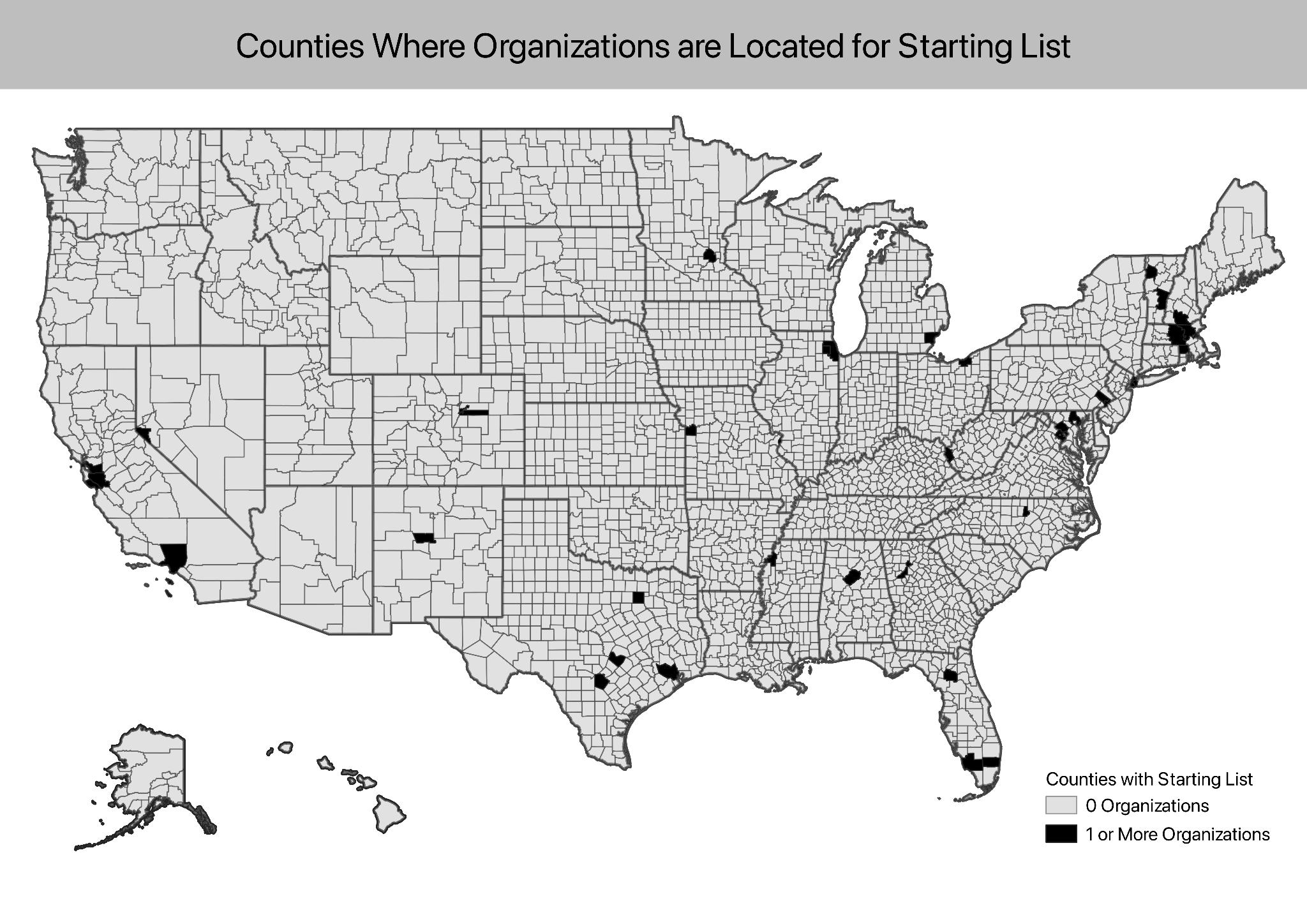
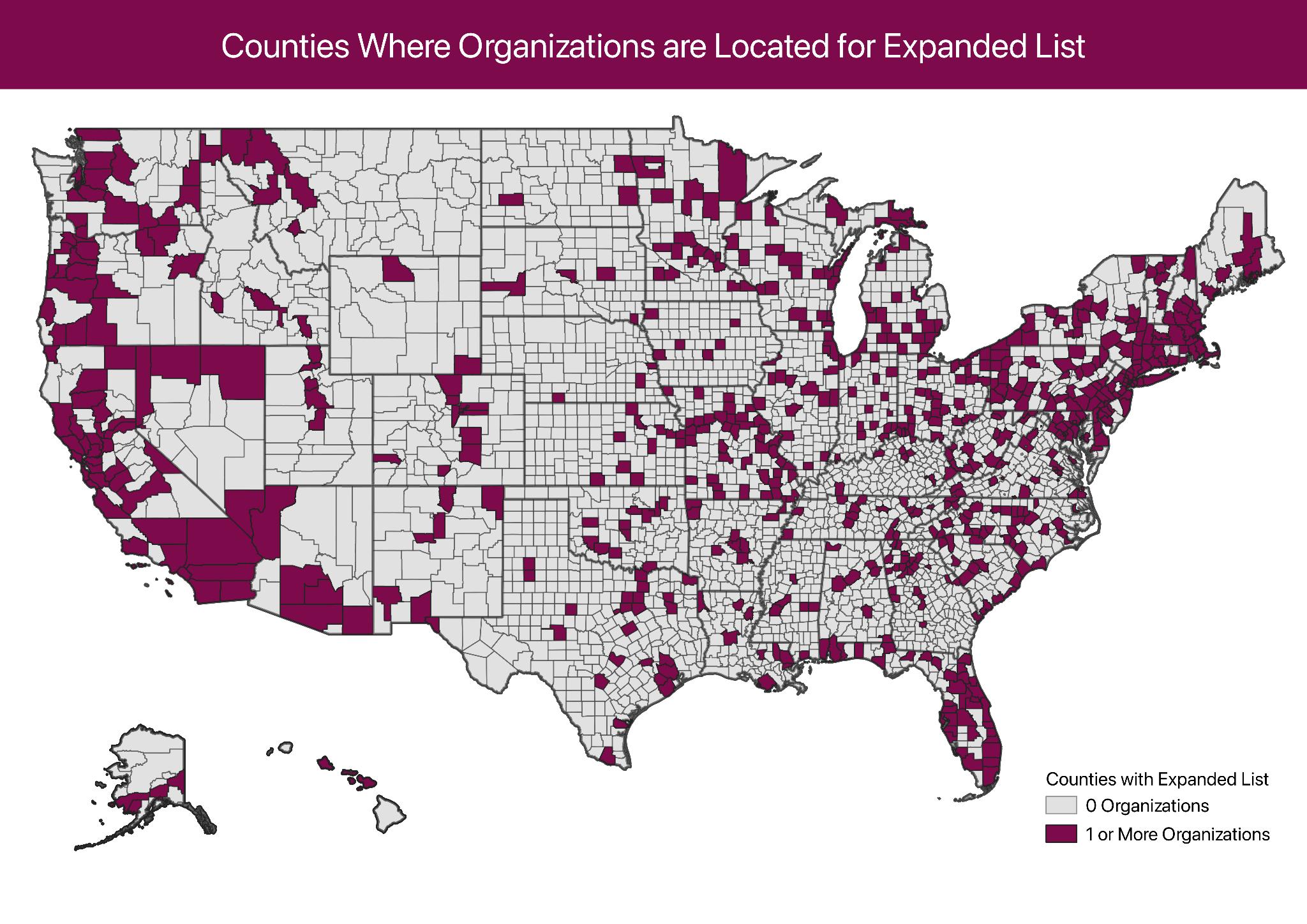
Our Contribution: Creating a Public Good
By taking a human-centered algorithm design approach, we are attempting to hold ourselves accountable while also making it easier for others to replicate our efforts By sharing our dataset and methodology, people will know what we did and how we did it. We wanted to create a public good to enable funders elsewhere to replicate this work in their institutions These include:
1. Our methodology for designing the algorithm, which includes co-designing with stakeholders We have also shared instructions for recreating the algorithm and dataset on GitHub. This includes the solution architecture, down selection criteria, and all supporting code
2 The final dataset of organizations that fit our criteria will be available upon request. We share it with the caveat that we created this list to meet the specific criteria for the New Profit economic mobility portfolio While expansive, it is not exhaustive
We aim to encourage a more expansive and inclusive approach to philanthropy, especially to raise up historically undercapitalized social entrepreneurs
Our Learnings: Beyond the Algorithm
We put human beings at the center of our work, not just by keeping their needs front of mind but also by taking the time to find out what those needs are via direct interviews, rather than relying on secondary data The weaving together of qualitative and quantitative data was essential; it both expanded our pipeline and will enable us to adapt and learn over time
Uncovering this data had the added benefit of informing us of our biases. If we saw an early output missing organizations that represent and serve an entire demographic group, we knew the process was inequitable and needed adjustment So the data itself creates a cyclical process
However, our interviews not only provided us with a set of insights and referred organizations to inform the algorithm design, but also challenged us to think beyond the creation of a novel dataset and tool to how we design for equity in all stages of the grantmaking cycle. Interviewees underscored for us the current challenge in philanthropy that this project aims to address Four key takeaways from these conversations included:
➔ Speak in the language of those doing the work
We heard that historically undercapitalized social entrepreneurs often don’t see themselves as a fit for, are skeptical of, or remain unaware of opportunities for philanthropic funding Even when folks are aware of funding opportunities, the perspective that “I don't know anybody there, so why would I ever apply?” keeps social entrepreneurs from submitting an application. Perhaps one reason for this is the language used in funding circles, which often doesn’t align with how social entrepreneurs describe themselves and their work
➔ Invest in trust-building
We heard concerns about funders using algorithms as a shortcut rather than a first step in a very
human and relational process of connecting with and getting to know potential grantees For example, one interview remarked, “I worry that when folks hear algorithms, it’s their new quick way to do an RFP,” and another said that in their experience, “philanthropy is actually quite lazy in developing pipeline relationships”
➔ Push beyond “who you know”
As one interviewee put it, “I think on the not missing [social entrepreneurs and organizations]; it comes from how you source and, again, I think it's how do you reverse why the existing system looks the way it does So, the existing system works the way it does because white people know white people, and they recruit white people” This reinforced our understanding that inequity in funding opportunities can be in large part due to “who you know" or “where you ' re based,” reflecting larger historical and structural inequities
➔ Leverage local network nodes to understand proximal players
Several interviewees urged funders to work with local partners, those who are known and connected to communities, to “really unearth people doing the real work” “I think a suggestion would be to have a group of folks [to help identify SEs and organizations] who are funding intermediaries and... are the ones who have the relationships and have done the legwork to identify leaders who have never been elevated to the national scene but have always been doing the work I just don't think it's reasonable that national folks deeply understand the ground game "
Our Next Steps: Advancing Economic Mobility
To create equitable outcomes and real systemic change, the algorithm must be just a piece of a large collection of equitable grantmaking practices 11 We dedicated considerable effort to ensuring that our human-centered algorithm and the resulting pipeline would expand our view and understanding of organizations doing this work as a prerequisite to relationship-building and outreach It does not make funding decisions for the team Nor does it narrow, filter, or shortlist Already, the algorithm is providing us with a much larger number of organizations than were previously on our radar
An expanded pipeline is only the start It will increase the number and range of organizations we explore, making for a more inclusive list for investment But to effect change, we need mindsets and capabilities within philanthropic organizations to evolve as well. We must also engage in more informed outreach and relationship-building, lowering the barriers for prospective applicants, asking better questions, and continuously rethinking our assumptions about the ways that individuals and organizations are positively impacting economic mobility in the United States.
Engaging in responsible design requires us to continually adapt and learn as we identify and grapple with our biases and how they may show up in both our processes and final products It emphasizes the importance of transparency and accountability and guides us to keep increasing our knowledge base In sharing our process with the larger philanthropic community, we hope to continue to learn and unlearn processes for identifying and supporting impactful, innovative, community-driven solutions that advance economic mobility across the United States.
Notes
1. For details on patterns of giving, see Giving USA, 2023, USDA Economic Research Service, 2015, and The Bridgespan Group, 2009 For more on the disparity between racial equity needs and philanthropic giving, see McKinsey, 2023
2. Dorsey, C., Kim, P., Daniels, C., Sakaue, L., & Savage, B. (2020). Overcoming the Racial Bias in Philanthropic Funding Stanford Social Innovation Review
https://doi org/10 48558/7WB9-K440
3. Messano, F. J. (2019). Talented, passionate, and underrepresented: Investing in Latino edupreneurs NewSchools Venture Fund
https://www newschools org/wp-content/uploads/2019/09/Latino-Entrepreneur-Report pdf; New Profit (2020, February 24) Transforming the Social Sector: The Opportunity and Need for Action.
https://issuu.com/newprofit/docs/inclusive impact concept paper
4 For details on responsible design, see People Rocket’s approach:
https://peoplerocket com/who-we-are
5. Forshaw, T. (2024, February 1). The Case For Human Centered Algorithm Design. People Rocket
https://medium com/people-rocket/the-case-for-human-centered-algorithm-design-90b 93fa4ec84
6 Ferrario, A (2022) Design publicity of black box algorithms: A support to the epistemic and ethical justifications of medical AI systems Journal of Medical Ethics, 48(7), 492–494
https://doi org/10 1136/medethics-2021-107482
7. Rai, A. (2020). Explainable AI: From black box to glass box. Journal of the Academy of Marketing Science, 48(1), 137–141 https://doi org/10 1007/s11747-019-00710-5
8 IRS (n d ) SOI tax stats Annual extract of tax-exempt organization financial data
Internal Revenue Service (IRS).
https://www irs gov/statistics/soi-tax-stats-annual-extract-of-tax-exempt-organization-fi nancial-data
9. It’s important to note that the IRS has a 12 to 18-month lag in publishing Form 990 files online
10 New Profit’s starting list consisted of 99 organizations We were only able to obtain Form 990s for 62 of these organizations. Thus, the analysis in this table pertains to the subset of organizations for which we had available data
11 New Profit (2020, February 24) Transforming the Social Sector: The Opportunity and Need for Action https://issuu com/newprofit/docs/inclusive impact concept paper

